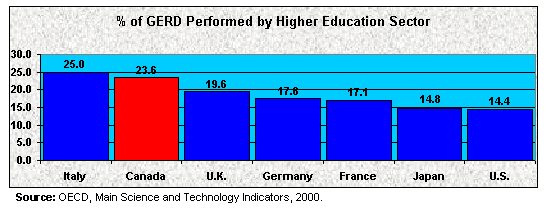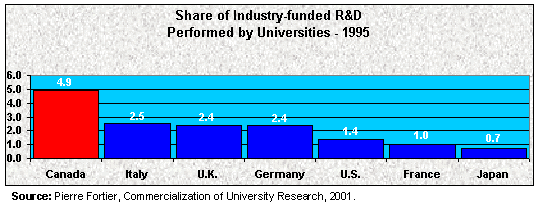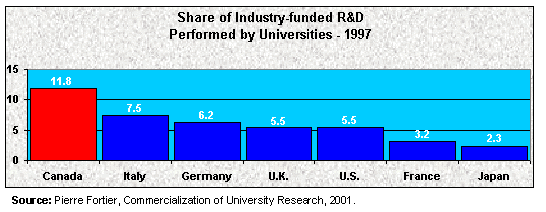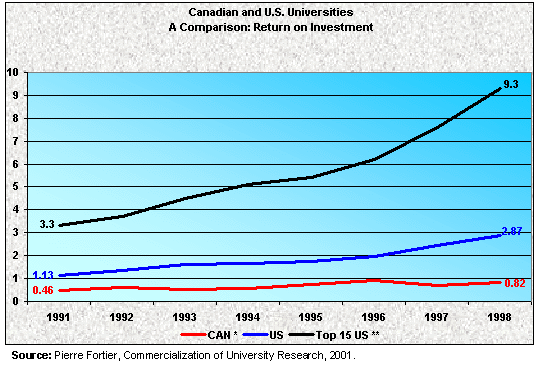INST Committee Report
If you have any questions or comments regarding the accessibility of this publication, please contact us at accessible@parl.gc.ca.
CHAPTER 10: UNIVERSITY RESEARCH, R&D COSTS AND COMMERCIALIZATION
Canadian colleges and universities make significant contributions to Canada’s social well-being and economic growth in three deliberate ways. First and foremost, they contribute directly to the nation’s economic performance by educating and graduating highly qualified personnel to meet the increasing needs of the workplace; they expand the boundaries of knowledge in all disciplines through basic and applied research, as they develop concrete solutions to selective challenges of industry and government; and they contribute to the economic and social well-being of their surrounding communities.
The Committee intends to address the second of these three roles — basic and applied R&D — and will suggest ways of improving this contribution by colleges and universities without compromising the others. Indeed, because research and educating functions are highly complementary, as scholars who build on our stock of knowledge are better able to teach their students and students gain valuable experience when working with faculty on research projects, the Committee is convinced that its proposed commercialization agenda will financially assist colleges and universities at being better in all three functions.
Relatively speaking, Canadian universities perform more R&D as a percentage of total R&D undertaken in the country than do their counterparts elsewhere in G-7 countries, except Italy. In fact, Canadian universities accounted for 23.6% of all R&D activity across the country in 1998 (see Figure 10.1). Moreover, while outsourcing 5% of their total R&D to universities (see Figure 10.2) and financing 12% of university R&D (see Figure 10.3), Canadian firms rely more on the university as a source of innovation than do those of any other G-7 country. The university sector also co-authors an impressive number of research publications in collaboration with industry.8 The quality of academic research and its efficient transfer to industry are, therefore, especially important in Canada.
At first glance, the impressive relative R&D performance of Canadian universities is particularly surprising given that the Canadian government’s funding does not cover the indirect costs of the activity, whereas virtually every other major competitor country of Canada’s does. However, on second thought, the relatively low GERD-to-GDP ratio, the smaller defence budget, and the lack of government funding of indirect costs of research oblige Canadian universities to seek and rely more extensively on the private sector for funding of its R&D activity. Paradoxically, then, this unusually great performance of Canadian universities in R&D is actually a cause for concern.
Figure 10.1

Figure 10.2
Figure 10.3
Indeed, the Committee has discovered that the federal government’s reluctance to cover the indirect costs of R&D when funding the activity has a couple very serious implications for universities. In the first case, the lack of coverage of the indirect costs of R&D means that a portion of the university budget that would have otherwise been allocated to students or capital requirements may have been diverted to R&D activities. Insufficient federal funding of R&D thus means that students and the community in which the university serves may suffer.
[…] — the principal investigators, the people without whom research would not take place — are paid for largely by the university. When I say university, I mean shorthand for university core funding as provided by provincial transfers and student tuition fees. That’s what I mean by university. They are paid for by the Canada research chairs program and in 170 cases out of about 9,000, by the NSERC chairs program. The rest of the professors, then, are paid out of university budgets. [Thomas Brzustowski; 23, 10:36]
Secondly, there are implications for research capacity in Canada, particularly among Canada’s small universities:
[A] number of us from NSERC, from our senior management visited 11 universities in Atlantic Canada and 5 in the prairies to find out what their problems are in capacity building and our conclusion was ... They simply for whatever reason don’t have those facilities and the capacity to provide those services. We believe that capacity building in the smaller universities needs to focus first and foremost on providing these services. That will allow the faculty members there to become more productive and succeed better in the national competitions.
[Thomas Brzustowski; 23, 10:40]
Where the Committee departs from this view is that we posit a reason why small universities do not have "the facilities and the capacity to provide these services." We believe there is a causal connection between the lack of federal funding of the indirect costs of R&D and capacity to undertake R&D, particularly at the smaller universities across the country. This is not the only reason for insufficient research capacity — for example, the lack of a well-established graduate program at some small universities would be an issue — but it likely is a significant contributing factor.
Among the experts appearing before the Committee, it was unanimous that before universities could contribute further to the federal government’s innovation agenda that would double the amount of research done in Canada, we must first address the shortfall in funding of the indirect costs of R&D.
[U]niversities have reached a point at which they will no longer be able to sustain federally sponsored research unless the issue of indirect cost is substantially addressed. [Robert Giroux; 23, 9:30]
In fact, all higher education stakeholders appearing before the Committee said that they welcomed the new programs for support of research such as the CFI, Canada Research Chairs Program, Genome Canada, and the Canadian Foundation for Climate and Atmospheric Studies, but that this funding brings both new work and a new administrative burden that costs them real dollars, in some cases dollars they do not have.
We will not be on a level playing field with our major adjacent competitor until the issue of indirect costs is met. Our universities and research institutes across the country have a significant role to play in the innovation agenda. We need to be equipped to do the job. Provision of indirect costs will allow universities to upgrade their information technology services for transfer of research data, and to take advantage of the high speed communication links between institutions; to upgrade animal facilities; to provide for safe, high quality animal care for assessment of new treatment methodologies; to provide better support for human ethics reviews; and to provide the administrative support for more rapid uptake of the proved projects. In addition, information on library resources for researchers will be able to be adequately supported. That is the kind of equipping universities and their research institutes need to be competitive. [Bruce Hutchinson, Canadian Association of University Research Administrators; 23, 9:25]
These costs are also more constraining at the smaller universities:
[I]n addition to reimbursement of the indirect cost of research, smaller universities will require assistance to develop their research capacity in a sustainable way. As you well know, the potential to innovate exists in all of our 92 universities across the country. Many of our smaller universities consistently demonstrate that they can excel by exploiting their strengths. No one institution or region owns the monopoly on good research ideas. They can, and should be encouraged in all parts of the country. It is time for a federal initiative that would develop sustainable research capacity and enhance underdeveloped research within smaller institutions to serve that purpose. This initiative would allocate funds to smaller institutions on a competitive basis to help them establish the foundation and addresses the challenges they face in building regional programs or initiatives that reflect both institutional and regional priorities. [Robert Giroux; 23, 9:35]
The Committee agrees with these university research stakeholders that this historic oversight in the funding of university research must be redressed. The Association of Universities and Colleges of Canada (AUCC) contends that the federal government should reimburse universities for their indirect cost of research at a nominal rate of 40% over and above the direct costs, and would have this rate adjusted upwards for smaller universities to reflect their higher cost structure. The Committee, however, will not put an exact figure on such a proposal, but will instead provide a general economic formula for covering all the costs of university research. The Committee recommends:
16. That the Government of Canada analyze the direct and indirect research costs at Canadian universities and colleges. Based on this information, the Government of Canada and provinces negotiate a new funding agreement that would take into account direct and indirect research costs and also the differential between large and small universities and colleges.
Research grants on this basis should allow the principal investigator to negotiate a reduction in his teaching load to pursue his research interest without imposing an undue burden on the remaining teaching resources.
The Committee also has other, more general, concerns with the current levels of funding afforded post-secondary education. The present Canada Health and Social Transfer (CHST) may not lend itself to the kind of targeted transfer needed to increase the capacity, and improve the infrastructure, of our universities and colleges. The Committee will, therefore, examine this aspect of post-secondary education and research in the fall.
The Government of Canada, in its budget for year 2000, provided $900 million to establish and sustain 2,000 Canada research chairs that would be administered by the three granting councils. Under the Canada Research Chairs program, these new research positions were created to strengthen degree-granting institutions across Canada — from large universities with research strengths across a variety of disciplines to smaller institutions with more focused research capabilities. About half of these positions would seek to attract established world-class researchers and the other half would seek to support those institutions that have demonstrated the potential to achieve world-class standing in their area of research.
The program’s key objective is to encourage the building of a critical mass of world-class researchers in order to help Canadian universities achieve research excellence. Universities were to develop comprehensive plans describing their research priorities and strategies. Applications from universities for individual positions would be evaluated against these strategic plans by review panels established by the granting councils.
Events following the announcement of the Canada Research Chairs program have been troubling to the Committee. The preponderance of research positions was allocated to the largest of universities, with 6% going to smaller universities. While the exact allocation process was not explained to the Committee in detail, we were told that it was largely based on past performance or past competitions for research grants:
[T]he distribution of the research chairs was based on the university’s success in the past in granting council funding … AUCC made strong representations at the time to have a different distribution so that some of the chairs that would have been going to the more successful universities would be going to the smaller universities. We have succeeded partially, maybe not as much as we could, but there has been a redistribution of the chairs towards the smaller universities on that basis. [Robert Giroux; 23, 10:10]
Apparently, the government perceived the research capabilities of smaller universities as deficient in some way. When it was realized that this was unacceptable, a quota was established:
[T]he government being sensitive to it, 6% of the research chairs were allocated to the smaller institutions, which meant 6% more chairs were allocated to them than would have been allocated had we gone on a straight proportional allocation of the chairs, the overall. [Robert Giroux; 23, 10:15]
This decision was then described as a great accomplishment:
[T]he Canada Research Chairs Program is quite exceptional precisely because of this concern, which at the beginning was to set aside percent of the research chairs for small universities. That was truly an excellent decision. In fact, when you think about a small university with 4,000, 5,000 or 3,000 students, that receives 5 or 6 research chairs for $200,000 per year over a seven-year period or $100,000 for five years, it would need 3 million dollars in capital to establish such a chair. For a small university that receives 5 or 6 chairs, that can make a huge difference in its research ability and leadership in research. [René Durocher, Social Sciences and Humanities Research Council of Canada; 23, 11:50]
The Committee is unable at this time to determine if the allocation of the 2,000 Canada research chairs was handled in an equitable manner, but it does believe that the apparent method chosen raises serious concerns on grounds of efficiency — that is, on whether the best or least-cost way of expanding capacity is being taken. Because the research chairs were created as one component of an innovation agenda — an agenda focused on the future — it seems rather contradictory to allocate these positions based on historical performance. Using past performance as a decision criterion means the future is condemned to reflect the past, which we know in advance favours large universities with strong research capacity over small universities with poor capacity. It is not surprising, then, that these Canada research chairs, which were touted as a way to build new research capacity at Canadian universities, ended up mostly in the hands of large universities, thereby simply reinforcing, if not augmenting, the existing disparity in research capacity across the country. This disparity may further be compounded by the larger universities raiding the smaller universities for their best and brightest faculty members. Knowingly tilting an already "unlevel playing field" further towards large and against small universities clearly calls into question the "set of values" held by these decision-makers.
The Committee would have preferred to see these positions offered up in an open competition to the best bids based on transparent and legitimate research plans and capability criteria. If it were thought that this method would still be biased towards the larger universities, then the 6% quota for smaller universities would have remedied the inequity consideration. In this way, the 94% of research chairs won in the open competition, whether won by large or small universities, could not be subject to criticism on efficiency grounds without calling into question the criteria (something that could have been handled by a request for comment from the stakeholders at the outset). The primary difference between what the Committee proposes and what appears to have happened is the orientation of the decision: ours focuses on the future, which is the direction to which our policy compass should be pointed.
The Committee could not, because of time constraints, pursue these concerns at the present time. When it examines the granting councils in greater detail this fall, the Committee also intends to pursue the distribution of the Canada research chairs.
Commercializing University R&D
For many higher education stakeholders, the commercialization of university research is an area of concern; it preoccupies the Committee as well. At the outset, and as was stated above, the Committee believes that universities and colleges have three roles to fulfil and we do not want to see one being compromised for the other. At the same time, and as the Committee recommended in its earlier report entitled Research Funding: Strengthening the Sources of Innovation, Canadian universities and colleges need to strike a proper balance between the amount of basic and applied research they do.
The Committee was told that Canada scores well on some terms of commercialization, but scores poorly on others. For example, according to Statistics Canada’s latest survey,9 a total of 52 AUCC members are actively engaged in the management of their intellectual property. Together, these institutions account for 98% of sponsored research in Canada.10 The most recent survey undertaken by the Association of University Technology Managers confirms that Canadian universities are making a solid contribution to commercialization, notably in terms of invention disclosures, licences executed, and spin-off companies created.11 These results are viewed as more remarkable given that the environment for commercialization activities in Canada is less favourable than in the United States; the U.S. is described as the world leader in this regard, principally due to the Bayh-Dole Act of 1980.
Figure 10.4
The favourable U.S. position relative to Canada shows up in the return on investment data as depicted in Figure 10.4. Colleges and universities in the U.S. have a return on investment approximately three times greater than that of Canadian universities. In looking to the United States as an example, it was suggested that:
[O]ne of the key policies which was made in 1980 was to pass legislation to say from now on when researchers develop intellectual property it won’t belong to the government, it will belong to the university where the research is performed with the obligation for that university to organize a commercialization office and to commercialize and to do it in such a way that it favours the American enterprises and preferably the SMEs … [Pierre Fortin, Commercialization of University Research Panel; 23, 9:40]
On this point, the Committee was told:
[L]arge universities, research-intensive universities in Canada, already have policies that support commercialization of research from university inventions. Some of them have been very successful. I just wanted to talk about three examples. I think we would all recognize one is the University of Waterloo where the inventor owns. Another would be University of British Columbia that’s been quite successful where the university owns and my own university, Queen’s University, that has been quite successful in commercialization of research where again the inventor owns and we have agreement around how one can commercialize research and get benefits from that. So I think we would all point to those three examples with different policies having a significant impact on their local economies and on commercialization of research. [Bruce Hutchinson; 23, 9:50]
It was further suggested something similar should be adopted in Canada:
There is a need to have a benefit-to-Canada clause. There is a need for researchers to disclose federally funded IP that they commercialize to their universities, which in turn must disclose it to the government. We have to have a policy on IP ownership. There is a need to have incentives and universities must submit policies which adequately reward innovative researchers for federal approval.
[Pierre Fortin; 23, 9:10]
Many universities in Canada, however, are not prepared in terms of commercializing their research results:
Since a number of members of our organization are involved in commercialization of research, I would be remiss not to indicate our support for assistance in the commercialization of research from universities. While a small number of universities could claim to be internationally competitive, the majority are not equipped at this time to build on their potential to contribute to the regional and national economy. [Bruce Hutchinson; 23, 9:25]
For this reason, most witnesses appearing before the Committee recognized the need for, and supported the development of, a commercialization policy in Canada:
[W]e do support commercialization. … In fact, we do cite statistics and we say that if all the right policies are in place, if the right kind of support is in place and that includes very much the indirect costs and the capacity of the smaller institutions we feel universities can triple the situation that they’re in right now and that of course are patents and licensing and spin-off companies and a number of these activities, and particularly, the revenues that they get from commercialization.
[Robert Giroux; 23, 9:45]
However, within the teaching community there is a spectrum of views beginning with those who believe that teachers and universities should have nothing to do with the IP business to those who will "fight tooth and nail" to preserve their right to create and protect their IP. The first camp holds that:
Neither individual professors nor universities should own the knowledge they create. It’s paid for by the public. … [I]t should go directly into the public domain. The first concern is that if you treat the results of academic work simply as property, scholarly communication is going to suffer greatly. The worry is that professors will become more interested in keeping quiet about a discovery in the hopes of making a profit off it than in sharing the knowledge they’ve created … The second concern … is that when universities focus simply on creating products or creating intellectual property, they abandon the tradition of university research in the public interest. [Paul Jones, Canadian Association of University Teachers; 29, 11:20]
The second camp holds that:
They want to preserve [their IP], to exploit them. They see these rights as a legitimate recognition of the work they’ve done, the scholarly toil they’ve engaged in. … "Every prof a millionaire" is one of their rallying cries. [Paul Jones; 29, 11:25]
The Committee recognizes that there is no unanimity on the question of whether to commercialize or not. However, the Committee is fully aware that the framing question is not whether university and/or professors should commercialize or not — because they can commercialize, and indeed have done so already, without the federal government’s say — but whether there should be laissez-faire or rules and/or guidelines governing commercialization efforts of universities and scholarly professors. There are merits on both sides of this question; however, the Committee sides with the need to develop a commercialization policy of university research in the hope of improving Canada’s record at turning good ideas into products and services, as well as ensuring commercialization efforts do not overtake public interest concerns on producing the knowledge workers of tomorrow. Although the Committee is not at this time in a position to suggest the specific components of such policy, we recommend:
17. That the Government of Canada, after consultation with the provinces, develop a comprehensive policy on the commercialization of university and college research that would include rules on disclosure, ownership of results and administration issues.


